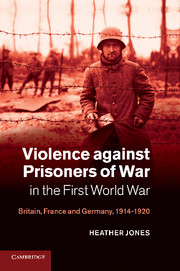Book contents
- Frontmatter
- Contents
- List of illustrations
- List of tables
- Acknowledgements
- Abbreviations
- Introduction
- Part I Propaganda representations of violence against prisoners
- Part II Violence and prisoner of war forced labour
- Part III The end of violence? Repatriation and remembrance
- Glossary of foreign terms
- Bibliography
- Index
Part I - Propaganda representations of violence against prisoners
Published online by Cambridge University Press: 05 January 2014
- Frontmatter
- Contents
- List of illustrations
- List of tables
- Acknowledgements
- Abbreviations
- Introduction
- Part I Propaganda representations of violence against prisoners
- Part II Violence and prisoner of war forced labour
- Part III The end of violence? Repatriation and remembrance
- Glossary of foreign terms
- Bibliography
- Index
Summary
Introduction to part I
Violence poses a challenge for historical analysis, as it encompasses both the reality of the human experience of physical force and the discursive web of perceptions, rumour and narrated meanings which regulates and interprets that reality. To understand a particular wartime violent action, it is thus necessary to consider it in the context of the different meanings which make up its discursive web. For this reason, the first section of this study will closely examine how, early in the war, popular meaning was attributed to particular accounts of violence against captives. The purpose here is to find out more about the crucial initial relationship between the violent incident and the cycle of wartime significations it provoked – in other words, how particular propaganda ‘cycles’ about prisoners developed out of real incidents of brutality against captives. Only by looking at how wartime societies perceived violence against prisoners is it possible to understand how such violence happened.
This will be done here by first examining in detail in chapter 1 how widespread civilian violence against prisoners of war in 1914 was represented in contemporary wartime media. Second, chapter 2 will explore how three early wartime propaganda ‘cycles’ concerning violence against prisoners led to the further radicalisation of prisoner mistreatment, through an examination of 1914–15 media debates surrounding the battlefield shootings of prisoners; accounts of prisoner beatings; and finally, the mistreatment of sick captives.
- Type
- Chapter
- Information
- Violence against Prisoners of War in the First World WarBritain, France and Germany, 1914–1920, pp. 29 - 32Publisher: Cambridge University PressPrint publication year: 2011
- 1
- Cited by

